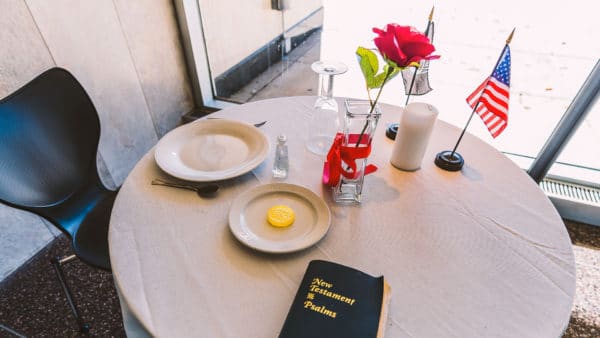Memorial Day is an American holiday observed on the last Monday of May, honoring the men and women who died while serving in the U.S. military.
The day is considered the unofficial start to summer and is traditionally celebrated with get-togethers, good food, and fireworks, while enjoying a day off from work.
But there’s another tradition connected to this holiday, one that is more solemn and poignant. It is the Missing Man Table.
Also referred to as the Fallen Comrade Table, this practice was established in 1993, following a directive from the U.S. Senate to establish a single office to deal with the Prison of War and Missing in Action issue.
The table is set up in military dining facilities of the US Armed Forces in honor of the fallen, missing, or imprisoned military service members. It serves as the focal point of ceremonial remembrance. These tables have even been duplicated in non-military establishments such as libraries and Chick-Fil-A restaurants. Some are even set up on street corners and in bars.
The setup of the Missing Man Table represents the emotions and feelings for those who did not come home. The ceremony of the table symbolizes that they are with us in spirit. Every item on the table has meaning and consists of these elements:

A small round table
The table is round to represent the everlasting concern that survivors have for the missing, fallen and imprisoned.
A table set for one symbolizes the isolation of the absent service member. During large events, the table may be set for six to represent each of the five armed services (Army, Navy, Marine Corps, Air Force, and Coast Guard), with the sixth place symbolizing the civilians who died during combat.
A white tablecloth
A white tablecloth symbolizes the pure intentions and innocence of service members who chose to serve their country.
A black napkin
A black napkin represents the emptiness that these warriors’ captivity provokes.
A single rose
A single rose symbolizes the blood shed by service members in sacrifice to ensure our freedom. It also represents the family and friends who faithfully await the return of their missing service members.
A red ribbon around the vase
A vase tied with a red ribbon symbolizes our continued determination to account for the missing. Although the ribbon has been temporarily broken, it’s still firmly in our grasp, and we will continue our search.
A slice of lemon
A slice of lemon represents the bitter fate of the missing.
A salt shaker
Salt symbolizes the tears shed by families waiting for their loved ones’ return or in memory of their fallen loved ones.
An inverted glass
An inverted glass represents the fact that the missing and fallen cannot partake in good times
A lit candle
A lit candle symbolizes the light of hope that lives in our hearts to illuminate the missing’s way home.
Head covers
One or more head covers may be placed upon the table to represent the armed service of the missing service member
A Bible
A Bible represents faith in a higher power, although it is not always used in the displays.
An empty chair (or chairs) or inverted chair
An empty chair (or chairs) represents the absence of the missing and fallen. In some instances, a chair will be tilted forward against the table as though being saved for someone. The empty chair symbolizes that although they are missing, they are not forgotten.



